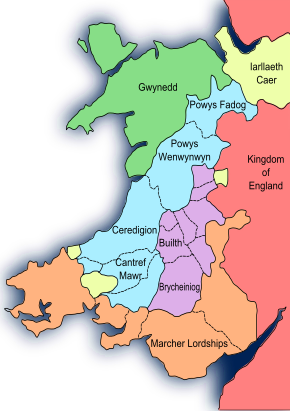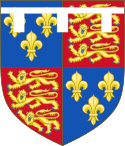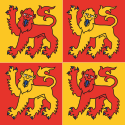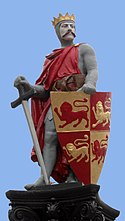Velšské knížectví
| Velšské knížectví Tywysogaeth Cymru (cy) Principality of Wales (en)
| |||||||||||
Geografie
| |||||||||||
| Obyvatelstvo | |||||||||||
| Státní útvar | |||||||||||
| Státní útvary a území | |||||||||||
| |||||||||||
Velšské knížectví (velšsky Tywysogaeth Cymru, anglicky Principality of Wales) byl státní útvar podřízený Anglickému království, existoval mezi lety 1216 a 1536. Jeho historie začíná dobytím nezávislého Walesu anglickým králem Eduardem I. Eduard spoutal Wales kruhem královských hradů a zavedl titul „Kníže velšský“ (Prince of Wales), jehož držitelem je následník anglického (dnes britského) trůnu. Proti anglické nadvládě se několikrát zvedl odpor, největší povstání vedl v 15. století Owain Glyndŵr, který si uchoval nad Walesem kontrolu po několik let. V roce 1536 byl Wales plně připojen k Anglii, velšská legislativa spojena s parlamentem ve Westminsteru.
Historie

Po celý středověk provázel Wales boj s Anglií, tedy nejprve s Anglosasy a posléze Normany. Obsadit Wales se podařilo až anglickému králi Eduardu I. na konci 13. století.
Dobytí Walesu
Král Eduard vydal nařízení, kterým omezil platnost velšských zákonů a nechal postavit soustavu kamenných hradů, které měly udržet anglickou nadvládu nad Walesem. Završením nadvlády bylo udělení titulu prince z Walesu jeho nejstaršímu synovi a dědici roku 1301. Wales se stal součástí Anglie, i když jeho obyvatelé mluvili odlišným jazykem a měli odlišnou kulturu. Angličtí panovníci zřídili velšskou radu, jíž občas předsedal následník anglického trůnu. Rada se běžně scházela v Ludlow.
Velšané se proti anglické nadvládě několikrát vzbouřili. Roku 1400 velšský šlechtic Owain Glyndŵr vedl povstání proti Jindřichovi IV. Pod jeho vedením velšské vojsko mnohokrát porazilo Angličany a po několik let kontrolovalo většinu země. V té době bylo také svoláno jednání velšského parlamentu a vytvořen plán na založení dvou univerzit.
Ovládnutí Anglií

Angličané nakonec byli schopni obnovit svou moc nad Walesem, ale Glyndŵrovi se podařilo uniknout. Jako reakci na tuto vzpouru byl anglickým parlamentem vydán roku 1402 zákon, který zakazoval Velšanům nosit zbraň, zastávat úřad a bydlet v opevněných městech. Tato omezení se také vztahovala na Angličany, kteří se oženili s velšskými ženami. Jindřich VIII. inicioval v letech 1535 až 42 přijetí zákonů, na jejichž základě se stal Wales součástí Anglie, velšské zákony byly zrušeny a velština zakázána jako oficiální jazyk. Byly ustanoveny hranice Walesu a zástupci jeho hrabství byli voleni do parlamentu.
Symbolika
- vlajky:
- Llywelynův prapor kolem 1240–1282
- erby velšských knížat, resp. Walesu:
- 1911–současnost
Související články
Média použitá na této stránce
Autor: Jorellaf, Licence: CC BY-SA 4.0
Banner with the traditional arms of the House of Aberffraw, rulers of the Kingdom of Gwynedd, attributed to Llywelyn the Great (d. 1240). Recorded in the Chronica Majora (c. 1250).
Autor: AlexD, Licence: CC BY-SA 3.0
Flag of the Welsh Kingdom of Powys and the House of Mathrafal.
Autor: AlexD, Licence: CC BY-SA 3.0
Banner of the personal arms of Llywelyn ap Gruffudd
Autor:
- File:Coat of Arms of the Prince of Wales (Modern).svg: Sodacan
- odvozené dílo Sodacan
'’’Coat of Arms of the Princes of Wales’’’ with France Modern
Autor: Sodacan, Licence: CC BY-SA 3.0
Arms of Edward Prince of Wales, later King Edward II
Autor: Sodacan, Licence: CC BY-SA 3.0
Traditional arms of the House of Aberffraw, rulers of the Kingdom of Gwynedd, attributed to Llywelyn the Great (d. 1240). Recorded in the Chronica Majora (c. 1250).
Autor:
- Coat_of_arms_of_the_Prince_of_Wales.svg: Sodacan
- derivative work: Sodacan (talk)
Shield of arms of HRH Prince William, the Prince of Wales (born 1982) son of King Charles III and Diana, Princess of Wales. The coat of arms was granted in 2022 to him as the Heir-Apparent to the British and Commonwealth thrones.
| “ | Quarterly, 1st and 4th Gules three lions passant guardant in pale Or armed and langued Azure (for England), 2nd quarter Or a lion rampant within a double tressure flory-counter-flory Gules (for Scotland), 3rd quarter Azure a harp Or stringed Argent (for Ireland), with over all a label of three points Argent, and on an inescutcheon ensigned by the coronet of the heir-apparent, quarterly, Or and Gules four lions passant guardant counterchanged (for the Principality of Wales). | ” |
Autor: AlexD, Licence: CC BY-SA 3.0
Map of Wales after the 1267 Treaty of Montgomery/Shrewsbury:
Autor:
- Coat_of_Arms_of_Albert_Edward,_Prince_of_Wales_(1841-1901).svg: Sodacan
- derivative work: Sodacan (talk)
'’’Coat of Arms of Albert 'Bertie' Edward, the Prince of Wales’’’ later King Edward VII
Autor:
- Coat_of_Arms_of_George,_Prince_of_Wales_and_Prince_Regent_(1762-1820).svg: Sodacan
- derivative work: Sodacan (talk)
'’’Coat of Arms of George, the Prince of Wales and Prince Regent’’’ later King George IV
Autor: lastest version Perhelion; earlier version AlexD, Licence: CC BY-SA 3.0
Banner adopted by Owain Glyndŵr and thought to be derived from the counter-charged arms of the princely Houses of Mathrafal and Dinefwr. It is currently in use by the National Eisteddfod for Wales, Cymdeithas yr iaith and widely amongst independentist groups
Autor: Sodacan, Licence: CC BY-SA 3.0
'’’Arms of Dafydd ap Gruffydd of Wales’’’
Autor:
- Coat_of_Arms_of_the_Stuart_Princes_of_Wales_(1610-1688).svg: Sodacan
- derivative work: Sodacan (talk)
'’’Coat of Arms of the Stuart Princes of Wales’’’ used by Henry Stuart, Charles I, Charles II and James Francis Edward Stuart (the Old Pretender)
Autor: Jorellaf, Licence: CC BY-SA 4.0
Square banner with the traditional arms of the House of Aberffraw, rulers of the Kingdom of Gwynedd, attributed to Llywelyn the Great (d. 1240). Recorded in the Chronica Majora (c. 1250).
Autor:
- Coat_of_Arms_of_the_Hanoverian_Princes_of_Wales_(1714-1760).svg: Sodacan
- derivative work: Sodacan (talk)
'’’Coat of Arms of the Hanoverian Princes of Wales’’’ used by George II, Frederick and George III
Autor:
- File:Coat of Arms of the Prince of Wales (Ancient).svg: Sodacan
- odvozené dílo Sodacan
'’’Coat of Arms of the Princes of Wales’’’ with France Ancient
Autor: Hogyncymru, Licence: CC BY-SA 4.0
c.1400 – c.1416 Y Ddraig Aur (The Golden Dragon), royal standard of Owain Glyndŵr, Prince of Wales, famously raised over Caernarfon during the Battle of Tuthill in 1401 against the English.
Statue of Llywelyn the Great at Conwy: the statue stands atop a drinking fountain. The work of art was designed by Grayson and Ould during 1895–98, sculpted by E.O. Griffiths, and unveiled in 1898.[1]






































